The Genesis of the Transcendental Terrantez Tasting
The idea for this event was initially generated back in January 2011, on the Madeira Forum area of fortheloveofport.com. By February of last year, this became a more serious discussion and within a couple of months the fuse was lit, and I quietly started to contact some Madeira mavens who participated in the forum.

The early stages of planning were taking shape for March 10th 2012. Mannie Berk of The Rare Wine Co. quickly caught wind that a Terrantez tasting was being planned and we spoke early and often about the possibilities. By autumn of last year, we began collaborating on what would likely become to be known as one of the all-time great Madeira tastings, and certainly the most comprehensive and historic lineup of Terrantez bottlings ever assembled (to our knowledge).
We put together a list of the finest Terrantez bottlings ever vinified, which we hoped to include and then combined our guest lists. Organizing a Madeira party of this magnitude, handled from opposite coasts in the USA made for a fun challenge. Although Mannie and I have joined forces on a handful of Madeira tastings over the years, this was far more ambitious and fun, as the participants hailed from seven countries in addition to a diverse swath of the USA.
By design, the core of this tasting was centered on a comparison of the three most legendary Terrantez vintages: 1862 – 1846 – 1795. However, there were many other important bottlings represented, the vast majority of which were pre-Phylloxera vintages. To put it in historical perspective, the oldest bottle at the tasting pre-dated the founding of the United States and the very youngest bottle was at least 125 years of age.
We were grateful for the generosity of all participants, and looked forward to sharing a memorable afternoon into evening with like-minded Madeira lovers.

What was notable about this specific lineup was that of the eighteen bottles, there were a dozen different producers included. Considering that there are so few Madeira shippers still in existence on the island today, it helped us to appreciate these rarities even more. Statistically speaking, the age of these Terrantezes was astounding, the aggregate of which was at least 3,220 years, resulting in an average bottle age of 179 years old.
Timing was important, lots of loving care was put into the proper decanting of the bottles, which all had at least four days of air time and most of which spent much closer to a week in decanter, some even longer. That would be a recipe for disaster with any other type of wine that I know of. The tasting was designed to explore the younger bottlings (1886/1887) at the beginning and naturally progressing to the older wines. The eighteen Terrantezes were broken into six flights of two, three or four bottles.
In order to properly evaluate and fully enjoy these venerable bottles with due deference, we allotted five and a half hours for the tasting, followed by a sumptuous dinner. Considering the group discussion that took place following each flight, it was nice to have enough time to visit and revisit each glass before us without being rushed. Mannie commented afterwards, that one of the really interesting dynamics of the tasting was the sheer focus and stamina of the group.

The management and staff at Del Posto deserve lots of credit for executing every detail to perfection. Located at 85 10th Avenue, NYC (212-497-8090) the beauty of their downstairs banquet room in close proximity to the wine cellar, can be seen in the photos. But not just a pretty face, the service delivered by the restaurant staff was exemplary. From pouring and portioning the Madeira, to the seamless service during our wine dinner afterwards, everything was outstanding.
The food itself exceeded my lofty expectations and several participants commented how much they loved dinner. The menu is included towards the end of the article, (together with our lineup of dinner wines). One serious foodie friend remarked that the cold and hot passed hors d’oeuvres were the best he’s encountered anywhere in the world. Sincere thanks to Del Posto’s Abby Blake – the Director of Private Dining, for nailing the complex logistics and set up; also to Jeff Porter – Wine Director, who deftly managed so many facets of our Terrantez tasting and diverse flights of dinner wines; and Mark Ladner – the Executive Chef, who made pairing those wines with extraordinary Italian cuisine, an art form.

Thanks to the collaboration of those who provided essential written works that bring the story of our transcendental event to life here. Some of the historical facts and lore on the Terrantezes included in our tasting originated from the individuals who shared their bottles and others who pooled their insight on specific bottlings.
But the heavy lifting was done by two individuals: Peter Reutter, (creator of the world’s best Madeira website: The Madeira Wine Guide) who was instrumental in assisting Mannie Berk, whose vast knowledge and passion for Madeira knows no bounds. Mannie spent countless hours researching and compiling data, and ultimately wound up writing the majority of the contextual info for a brochure given to all participants and shared in this article. Special thanks to Bob Maliner, (an early mentor in developing my thirst for Madeira) for providing access to several rare bottles at this event that few of us will ever see again, and recounting numerous anecdotes from his lavish Madeira tastings held in Florida. All auction sales data is from Noel Cossart's Madeira the Island Vineyard, 2nd Edition, The Rare Wine Co., 2011. The accompanying photography is the art and work of Hans Reutter and the tasting notes that follow are mine.

Bob Malner & Mannie Berk
The Participants
- Reidar Andersen – Norway
- Gary Banker – Massachusetts
- Mannie Berk – Connecticut
- Chris Blandy – Madeira
- David Boobbyer – UK
- Sean Corrigan – Arizona
- Paul Day – UK
- Marco DeFreitas – Connecticut
- Alan Gardner – Canada
- Roy Hersh – Washington
- Eric Ifune – Nevada
- Andrew Jones – Cayman Islands
- Stuart Leaf – New York
- Neal Martin – UK
- Bob & Veronica Maliner – Florida
- Steve Pollack – California
- Peter & Hans Reutter – Germany
- Steve Shapiro – Maryland
Terrantez's Remarkable Journey
By Mannie Berk, The Rare Wine Company
When Phylloxera arrived in Madeira in 1875, it would change the island's wine industry forever. It not only killed virtually every grapevine on the island, it also wiped out most of the companies that made and shipped the wine. And though the cure for Phylloxera would soon be found, all of the island's vineyards had to be replanted. And in the process, Terrantez essentially disappeared, as few growers considered this low-yielding, finicky variety worth replanting. It seems shocking from our vantage point that the grape that many believed was the island's finest would be allowed to disappear. After all, a large percentage of the greatest surviving Madeiras of the 18th and early 19th centuries were made from Terrantez. Its flavor and textural dimensions are unique, providing the rapier dryness of Sercial, with the richness of a great Bual. For sheer magnificence, there was really nothing like it. But the Madeira trade was in total disarray and there was little confidence of its survival.
Shortcuts were taken everywhere; and one of the most pervasive was to replace the viticultural diversity that existed in the 19th century with a mono-culture, as Tinta Negra Mole was grafted almost to the exclusion of the other classic varieties. With the advent of the 20th century, noble grapes likes Bual and Sercial became extremely rare, and a handful of varieties, including Terrantez, largely disappeared. In fact, according to the IVBAM, which regulates Madeira, by 2004 there was less than one hectare of Terrantez on the entire island. That's less vineyard area than Romanée Conti.
Fortunately, we have been blessed with a number of monumental Terrantezes that have survived from the pre-Phylloxera period, including a number from the 18th century. For their survival, we can thank the winemaking families themselves for having set aside these wines for the enjoyment of later generations. In fact, it is particularly striking that the great majority of wines in today's tasting came from the private stocks of the Blandy, Borges, Acciaioly, Leacock, Barbeito, Cossart and Hinton families. They were set aside, in Noel Cossart's words, "as a 'nest egg' or an investment against emergencies. They just kept them in wood, locked away, rarely drinking them except for a wedding or an anniversary."
It is a measure of the importance of these Terrantezes that they were singled out to be preserved. And it is a testament to their astonishing longevity that they have survived until today. We are indeed blessed to be able to experience them.
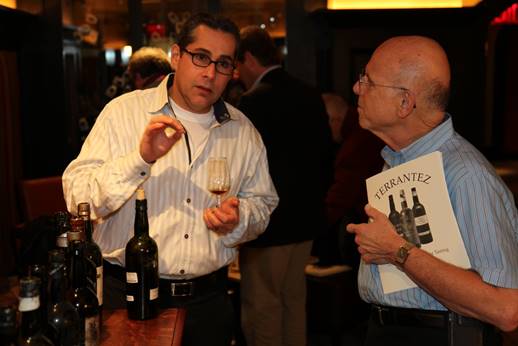
Marco DeFreitas & Steve Shapiro
The Terrantez Grape
By Peter Reutter, madeirawineguide.com
“As uvas de Terrantez, não as comas nem as dês, para vinho Deus as fez.” This old Portuguese proverb describes the value of the Terrantez grape, roughly translating to: The grapes of Terrantez are not for eating, nor to give them away, but for wine god created them.
Origin
The exact origin of the Terrantez grape is unknown. It had been cultivated in the Douro region in the early 16th century, which was long before it was recorded on Madeira island. In 1531, Rui Fernandez reports the grape to be widely grown at Lamego in northern Portugal. So Terrantez is certainly not an autochthonous grape of the island of Madeira. Since it has other names, like Cascal, Folgasao and Pied de Perdrix, it can also be assumed that Terrantez was grown in areas outside of Portugal. There are two more grape varieties called Terrantez in the Azores. However from an ampelographic point of view the Terrantez do Pico and the Terrantez da Terceira both are different from the Terrantez grown on Madeira.
History
Even though Terrantez has been recorded on Madeira island since the 18th century, it never had the importance and production numbers of the other “noble” grapes. It must have been considered of high quality though, since it seems that the name Terrantez was used for a positive description of other grapes. Verdelho as an example was sometimes named “Terrantez de Monte”. After the phylloxera crisis the real Terrantez nearly faced extinction.
In 1921 Silva and Menezes report that “it is cultivated on Porto Santo but appears to be extinct or almost extinct on Madeira.” Most publications about Madeira island and the viticulture of Madeira at the beginning of the 20th century don’t even mention Terrantez. And the modern guides to Madeira sometimes forget about Terrantez too. With the new EU-regulation of 1992, Terrantez is one of the officially recommended grape varieties for the production of Madeira wine. Today, efforts are under way to promote the replanting of Terrantez, but judging from the amount of grapes harvested in recent years, it still has a very long way to go.
In 2005 the total yield of Terrantez grapes was below 500 kg for the entire island. Even after five years of promotion this only rose to 2200 kg in 2009. On the other hand some producers have come up with new and rather expensive Terrantez blends that have been very well received by the market. This might ultimately persuade the producers to invest more effort into the Terrantez grape.
Ampelography
The shoot’s tip is open, with short and whitish woolly hairs. Also the young leaves look cobwebbed with hairs. The adult leaves often show three lobes with rounded small teeth at the edges. The stem’s cross section is U-shaped. The grape itself is of medium size, with densely packed berries of round shape, medium size and whitish color. Viala and Vermorel describe it as rather different in appearance from the Turruntes or Torrontes grape, of almost the same name, which is grown in the Rioja region and in Argentina.
Viticulture
Terrantez buds late in the season, with good resistance against powdery mildew, but is very susceptible to Botrytis Cinerea. The grapes ripen rather late which often leads to problems with humid weather. In general the grapes have medium high to high sugar content and that makes them even more prone for Botrytis. Terrantez is said to be difficult to cultivate and the yield is rather low compared to Verdelho and other grape varieties on the island. Since the growers are paid per kilogram of grapes delivered, most of them have not been very enthusiastic about replanting Terrantez.
Significance
There has always been a general agreement among Madeira wine experts and collectors that the Terrantez grape shows Madeira wine at its best. The unique spectrum of aromas, the good ageing ability, the almost ethereal quality and the characteristic flavors have always made this grape a favorite of the experienced connoisseurs. Add the rarity of the grape and it is easy to understand why old Madeira wines made from Terrantez have been and always will be relatively hard to find, even when the price of the bottle is not a factor. Therefore, to have a line-up of old Terrantez wines like the one we face today is nothing short of a medium-sized miracle.

Nwal Martin (Center) Meets Peter Reutter (Right)
The Transcendental Terrantez Wines: Provenance and Tasting Notes
Roy writes: Two last comments before the actual Terrantez notes are presented. Individual tasting notes may sometimes mislead, by conveying the impression that by having so many extraordinary ancient wines together in a flight (or tasting) the standout bottle seems to get all the love, while the others may get short shrift or seemingly less enthusiastic reviews. It should be noted that every one of these Madeiras would be welcomed as something exceptional on any given night.
The historical information that follows (in italics) was written by Mannie Berk and the tasting notes are mine. Please keep that in mind when reading the sections that follow:
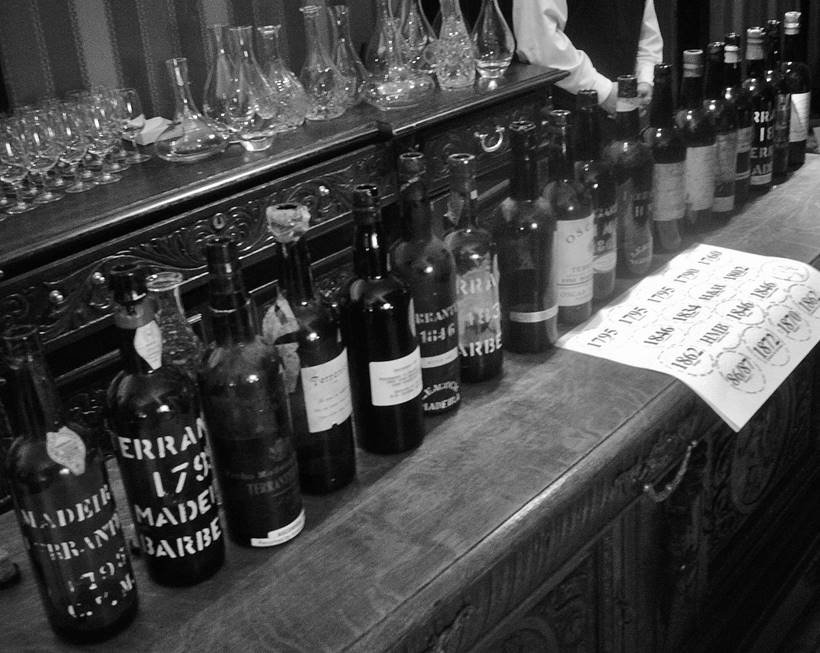
The Phylloxera Era – flight #1
1886/87 Blandy's (Steve Pollack) - A blend of two vintages from a time when production had been devastated by Phylloxera, this 1886/87 Terrantez once belonged to Graham Blandy. Like the 1795 F.F. Ferraz, this wine was set aside early in the 20th century for the enjoyment of the Blandy family. And in 1972, Graham gave three bottles to each of the three children with the advice to drink it "with reverence as being of a past age." This particular bottle was purchased by Bob Maliner from Christie’s on February 27, 1979, as "Lot 20, Bottled 1900, recorked 1962. From the private cellar of Graham Blandy." A total of three bottles have been noted as selling at auction since 1971. The bottle has a simple white label with black lettering. While such labels have sometimes been described as "Michael Grabham labels," they were almost certainly generated at the Madeira Wine Association. The label's misspelling of Terrantez ("Terrantrez") may or may not have been an accident. We've seen this misspelling also in Graham Blandy's own records.
1886/1887 Blandy’s Terrantez Vintage Madeira (Transcendental Terrantez Tasting) – It is rare to see Vintage Madeira bottled from two consecutive years. Medium amber-tawny color with golden rim. Penetrating and heady aromas of saline, toffee, mahogany, mixed nuts and VA. A taut, lip-smacking first sip of the day, which was as dry as I prefer Terrantez to be. Light-medium weight, possessing a tingling spine of acidity without appearing sharp. Although quite dry on entry, there was a subtle hint of lemon meringue sweetness which appeared in the mid-palate; a bit four square, framed by notes of hazelnuts, tangy grapefruit and a tart citrus finish of medium length. While supposedly bottled after only thirteen years of wood aging, it appeared this 1886/1887 may have actually seen more years in wood than expected. An excellent way to open the tasting and while it may have lacked a modicum of profundity if not equilibrium, I kept returning to this glass for more sips, as I appreciated its dry silhouette which flaunted my stylistic preference for dry, edgy Terrantez. Most other tasters were not equally enthralled. 92 points - 3/10/2012
1872 Quinta do Serrado (Gary Banker) – The parcel of 19th century Quinta do Serrado Madeiras sold at Christie's during 1989 and 1990 may have been huge (about 2,000 bottles), but it wasn't all the old Madeira the Henriques family owned. More wine remained in a family cellar in Funchal. The Rare Wine Co. purchased some of this wine in 1997, including a handful of very rare bottles of 1872 Terrantez. Little is known about this wine, except that it came from the same vast Cama de Lobos estate as the 1827 Bual and 1830 Malmsey sold at Christie's. Like the others, the Terrantez was vinified and aged on the property, which has been owned for centuries by the Henriques family. We know of no bottles having appeared at auction. In the late 1990s, the present bottle was sold by The Rare Wine Co. to a West Coast collector, who sold it back to them a decade later. Gary Banker purchased this bottle from RWC in October, 2011.
1872 Quinta do Serrado Terrantez Vintage Madeira (Transcendental Terrantez Tasting) – The coloration of the 1872 was just slightly darker than the 1886/87 at the core, with a broad straw hued meniscus. Initially exuding a funky / moldy bouquet that mostly blew off within the first half hour, leaving in its wake an earthy essence and spicy cinnamon, iodine, molasses, lemon-lime and a light whiff of VA. The Serrado was defined by a sweeter center with kumquat and fig flavors, surrounded by spice and lemony citrus. The sweetness seemed to overpower the acidity early on and maybe that was in comparison to the preceding glass, but for me the Serrado missed the intricacy expected from a top notch Terrantez. The acidity became slightly more apparent on subsequent sips and the texture was lusciously smooth and creamy. Overall, it showed well, yet lacked tension and seemed simple, delivering a finish of moderate length. 90 points - 3/10/12
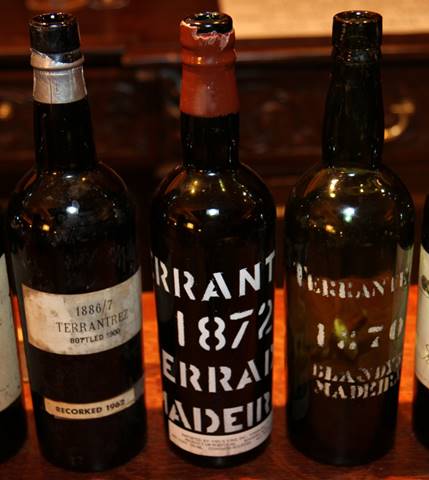
1870 Blandy’s (Steve Shapiro) – For his 1998 book, Madeira, Alex Liddell tasted a bottle of 1870 Blandy's Terrantez, which he said had been bottled at least 50 years earlier. The bottle we are tasting Steve's example was bottled in 1962. If both experts are correct about their bottles, today was purchased by Steve Shapiro in 1995 from Patrick Grubb. According to Patrick, they must be different bottlings, though each came from a private English cellar. In total, only 13 bottles of 1870 Blandy's Terrantez were noted as having been sold at auction between 1971 and 2010.
1870 Blandy’s Terrantez Vintage Madeira (Transcendental Terrantez Tasting) – Only the second time I’ve had this Madeira, previously, five years ago to the day. Medium dark caramel color with an orange-tawny rim. The bouquet delivers a big blast of complex scents including orange blossom, Indian spices, a sharp medicinal note, salty sea breeze, acacia flowers, sweet glove leather and a lifted whiff of VA. Medium in weight, ultra-smooth and fluid, the epicenter of the 1870’s fruit filled flavors exhibit a panoply of tropical edged sweet mango, ripe nectarine, and citrusy key lime with a supporting cast of crème caramel and walnut. More RS than I typically like in Terrantez, but the tart focus of the acid attack, richness in texture and stellar length of the finish provide enough character to keep it all in perspective. My favorite of the first flight. 93 points - 3/10/12
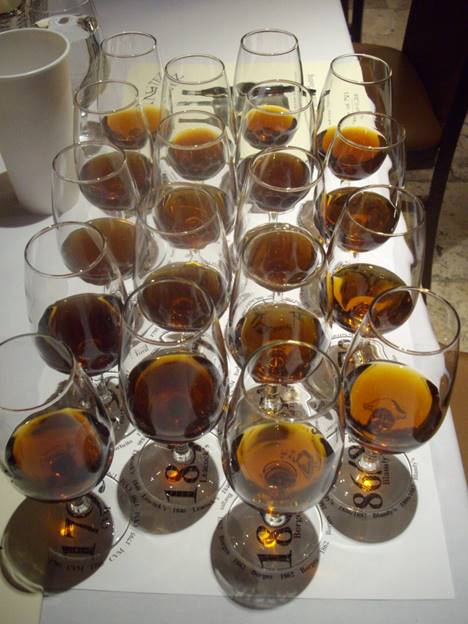
The 1862’s – flight #2
1862 Rutherford & Miles (Bob Maliner) – A rarity, with only three bottles reported as having been sold at auction between 1971 and 2010. While Bob Maliner has good records of many other bottles in his wonderful collection, this one is an exception. He describes it simply as "provenance unknown." As for the wine itself, because of its scarcity, and the fact that MWA wines appeared under multiple brands, this wine may well be the same as one or more of the other MWA 1846 Terrantezes: Cossart-Gordon, Blandy's or even Lomelino.
1862 Rutherford & Miles Terrantez Vintage Madeira (Transcendental Terrantez Tasting) – Medium dark coffee optic with amber-orange meniscus. Impressive earthiness from the inimitable first whiff; lots of minerality and herbs, sautéed morel mushrooms, leather and back loaded with fresh cooked caramel. Initially dry entry and full-bodied like a fine Verdelho, yet the sweetness didn’t come into play until the swallow. The cut of the acidity enveloped both tongue and salivary glands and never let up. This 1862 would have been really stunning had the mid-palate showed just a bit more intensity, although the flavor profile of white peach, cinnamon, clove and dates was pleasing. Nonetheless, the structure and the longevity of the finish were remarkable and I returned to this glass several times during the tasting, mostly for the exotic nature of its fragrance. 94 points - 3/10/12
1862 H.M. Borges (Marco DeFreitas) – 1862 Terrantezes can be just as confusing as the 1846s. They have appeared under the H.M. Borges, Cossart Gordon, Rutherford & Miles, Lomelino, Blandy's and Avery's labels, and perhaps others as well. Reported sources range from T.T. de Camara Lomelino; William Reid, founder of Reid's Hotel (which was the original source of two barrels bought by Noel Cossart in 1949), and the grower João Alexandrino Santos (the source of another 1846 that Cossart bought in 1936 and that reputedly was later sold to Avery's). The H.M. Borges bottling is surely the most famous--and the Madeira that Michael Broadbent famously wrote he would want as a desert island wine. According to Broadbent, Borges acquired this famous Terrantez from Lomelino. However, four bottles of 1862 Borges were also sold at Christie's that were catalogued as coming from Santos. Is this a cataloguing error, or are there two different 1862 H.M. Borges Terrantezes? Nineteen bottles of 1862 H.M. Borges have been noted as selling at auction between 1971 and 2010, exclusive of the four bottles attributed to Santos. The bottle we are tasting today was purchased in 2010 from K & L Wine Merchants, which acquired the bottle from a private seller. It bears an Esquin Imports (San Francisco) strip label.
1862 H.M. Borges Terrantez Vintage Madeira (Transcendental Terrantez Tasting) – The esteemed Madeira collector, Bob Maliner was at our tasting with his wife Veronica, and he was personally responsible for turning Michael Broadbent onto this bottling, which Broadbent fell in lust with. The coloration was nearly identical to the Rutherford & Miles in its molasses-like appearance. There was considerable bottle stink during the first hour in glass. It eventually dissipated, and an intriguing bouquet emerged with notes of vitamin pill, tobacco leaf, clove, cherrywood and stewed apricot. The HMB offered a viscous yet vinous and decadent mouthfeel, vibrating with an off-dry bittersweet essence of leather and woodsy flavors, laden with perky citrus tang and a sweet burnt sugar nuance that arrives late. The dry streak at the Borges’ core, and acidic tensity conveyed intricate precision, leading to an enduring aftertaste of tropical fruit and sweet vanilla purity. 97 points - 3/10/12

(L-R) Gary Banker, Chris Blandy, Steve Shapiro
Undated H.M. Borges (Neal Martin) – On December 11, 2008, Christie's sold an incredible 48 bottles of this wine, from the cellar of William Leacock. We know the quality of this wine is high, thanks not only to Christie's presale tasting, but to the two Leacock Collection tastings The Rare Wine Co. hosted in New York and San Francisco in 2009. But the question remains: what vintage is it? Unfortunately, William Leacock didn't know; the wine was acquired by his father or grandfather. Nor did Christie’s know. The sale catalogue stated that the vintage is “believed 1920s,” but during the presale tasting, this was corrected to “bottled in the 1920s,” with a possible vintage in the mid- to late-1800s. Inevitably, the speculation zeroes in on 1862, but why? Apart from the wine's quality, we’re attracted to the stenciling on the bottle, because of all the H.M. Borges Terrantezes, only 1862 is typically stenciled “TERRANTEZ HMB” on separate lines as are the Leacock bottles. The stenciling of the Leacock bottles also fits the physical description of two similarly undated bottles of “TERRANTEZ HMB” belonging to the late Tom Mullins—longtime Madeira Wine Association Director—that were sold at Christie’s in 1982 as “believed to be 1862.”
Undated H.M. Borges Terrantez Vintage Madeira (Transcendental Terrantez Tasting) – “Believed to be 1862” (from Leacock’s sale) also tasted June 7th 2009 in SF. This was considerably lighter in color than the other two wines in the flight, more similar to a light maple hue with a broad golden-green edge. The nose was reticent initially, but with some coaxing it evoked a spicy profile of potpourri, black pepper and espresso bean, framed by heady scents of VA and Satsuma. Rich, silky smooth and grapefruit tart up front, there was a green, herbal streak on the palate with lemon-lime citrus flavors in the middle and sweeter caramel and butterscotch at the end. Whereas the other 1862’s both showed a sense of power, here the intensity was ratcheted down a bit and although the acidity was ample, the finish did not linger long. A discussion ensued, and it was mentioned that there was little doubt this H.M. Borges was not the same as the 1862 HMB that preceded it, as supposedly the bottles had been binned on their side. For me, the color seemed significantly different and the overall profile was nothing alike. In fact, this didn’t even resemble the showing of the same bottle that I tasted back in 2009, which was great. 91 points - 3/10/12
 |
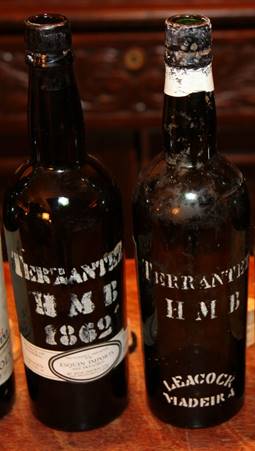 |
The 1846’s – flight #3
1846 H.M. Borges, Bottled 1900 (Roy Hersh) – We will never know the full story of 1846 Terrantez, but hopefully today's tasting will give us some insights. Terrantezes from this vintage have appeared under many labels including Blandy's, Borges, Hinton, Leacock, Cossart Gordon and Avery's, and some bottles have appeared with no shipper designation. Adding to the confusion are the multiple sources these shippers drew on, including H.M. Borges, Harry Hinton and Stephen Gaselee, the great British Madeira collector. Because of the number of the different brands, and their interrelationships, it has always been difficult to know which particular 1846 Terrantez is in which bottle--or even if they all had the same source. As for the H.M. Borges 1846, it originated with Borges himself in the late 19th century, although it is unknown where he bought the wine. His most famous--and according to Michael Broadbent the best--bottling was the 1900. There was at least one other bottling, 22 years after his death, in 1938. According to Alex Liddell, some of the 1846 Borges, 1900 bottling, was sold to Cossart Gordon and appeared under its label as well. We note 42 bottles of 1846 Borges Terrantez (multiple bottlings) having being sold at auction since 1971.
1846 H.M. Borges Terrantez Vintage Madeira (Transcendental Terrantez Tasting) – Bottled 1900. Medium maple tint with a golden-amber edge and slight cloudy appearance. Generous seductive scents that promise something special, imbued with minerality, smoky roasted espresso, soy sauce, briny sea air, peach marmalade and toffee. An incredible bouquet. Full flavored and fruit-centric, beautifully proportioned, yet light in body weight, possessing a soft vinous fluidity and razor sharp acid backbone. The Borges features a dark and dry stylish assemblage of fig, sultana and apricot fruit flavors interspersed with a hedonistic spicy-smoky soul. Given that the H.M. Borges was bottled 50 years earlier than the other three 1846’s at this tasting, its sheer elegance and precision were inspiring. A reservation preventing me from anointing a crazy high score was the underwhelming length of the finish and gentle heat on the aftertaste. Nonetheless, this Terrantez was class in a glass. 96 points - 3/10/12
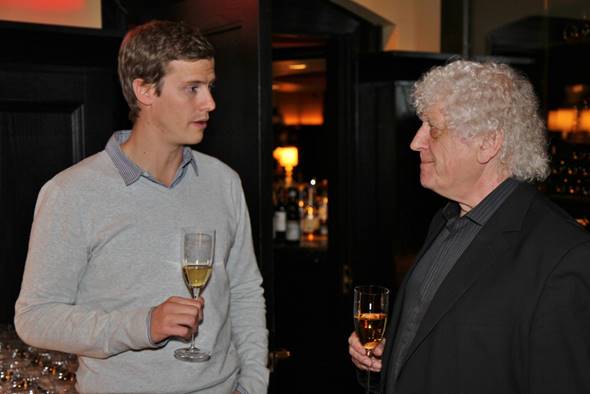
Chris Blandy & Alan Gardner
1846 Cossart Gordon Special Reserve (Mannie Berk) – Over time, Cossart Gordon sold at least three different 1846 Terrantezes: the 1846 Borges, bottled 1900; a 1906 bottling that originated with Harry Hinton, and a third Terrantez shipped to S.S. Pierce in Boston in the 1950s. We don't know if the third wine has any connection to the first two. The best information we have on this wine comes from letters written by California collector Roy Brady to Avery's and Cossart Gordon in 1958. In one of his letters, Brady quoted S.S. Pierce as saying "Cossart Gordon had only two small casks, and Mr. (Charlie) Codman persuaded them to bottle one of them for S.S. Pierce.” Brady also noted that it hadn't been in glass very long (meaning that it was probably bottled in the 1950s). This 1846 Cossart Gordon Terrantez cost Brady $11.75 a bottle. The bottle in today's tasting was one of five purchased in 2010 by The Rare Wine Co. from a prominent New York dealer of modern art who, with his wife, is also a collector of many other things.
1846 Cossart Gordon Special Reserve Terrantez Vintage Madeira (Transcendental Terrantez Tasting) – It was the darkest of the first eight wines, coffee colored and nearly opaque at the core, with a thin golden-green meniscus. Showcasing an explosive nose of pine resin and herbs, with a tantalizing backdrop of sandalwood, cinnamon spice, ripe Sekel pear and peach compote notes. Medium-full bodied, powerful and sinfully smooth texturally. The Cossart Gordon reveals a palate jam packed with a complex and diverse mélange of char, bittersweet Meyer lemon, roasted coffee, quince, Kahlua and torrefacted flavors; supported by tangy citrusy acidity that cleared a precise path to the unctuous and incredibly long lasting finish. One of the three greatest Cossart Gordon’s I’ve ever consumed and I hope to taste another bottle of this impeccably balanced Terrantez someday. 97 points - 3/10/12
1846 Avery's (Stuart Leaf) – In the 1950s and 1960s, Avery's was perhaps the richest source of very old and great Madeira in the world. From the time he joined the firm full-time in the 1920s, Ronald Avery kept his customers well-supplied with claret, Burgundy and Sherries, but then in the 1950’s he emerged as the great source of Madeira for British and American collectors. Most of his wines are believed to have come from one of two sources: the Madeira Wine Association and the estate of the late Stephen Gaselee. By the late 1960s, with little old Madeira left to buy, Avery wound down his Madeira business. Avery's sold at least two different 1846 Terrantezes. One was referred to, at least within the company, as the "reserve," which came from Stephen Gaselee (who died in 1943). The other was purchased in the late 1950s, presumably from the Madeira Wine Association. This wine undoubtedly has a connection to one or more of the MWA bottlings that bear the Blandy's, Cossart-Gordon or Leacock labels. But again which one(s)? The bottle in today's tasting is probably the latter wine, having MWA-like stenciling on the bottle. It was the single bottle of 1846 Avery's Terrantez in the Graham Lyons Sale Part II at Zachy's on December 3, 2010. Addendum: we sadly just learned of the passing of John Avery on March 23rd, 2012.
1846 Avery’s Terrantez Vintage Madeira (Transcendental Terrantez Tasting) – Medium dark cola color with orange-amber edge. Austere nose early on which required lots of coaxing. Once it opened up, the fragrances were fabulous with sautéed onion, mahogany, sultana, iodine, prune and espresso. Someone mentioned Bananas Foster and some participants agreed, although I was unable to detect that scent. There was an underlying sweetness and deep concentration of dark dried fruit character to this Terrantez’ profile along with acidic intensity and precision that played out in the middle and finish. The Avery’s flavors ranged from prune and figs to rich caramel and liquefied butterscotch with a slight bitter nut skin character, true to form for the grape. The finish continued on for several minutes while the interplay of the sweet butterscotch and bitter nutty edge was tantalizing along with the silky smooth texture. Another gorgeous 1846 and I was quickly learning why this vintage had earned such a legendary reputation for producing remarkable bottlings of Terrantez. Admittedly, the only 1846 I’ve ever had before this tasting was a mind blowing bottle of the Blandy’s, brought by Peter Reutter for a Madeira tasting I had organized in Seattle (2007). 97 points - 3/10/12
1846 Leacock, Bottled 1950 (Paul Day) – The 1846 Leacock Terrantez could be the most mysterious of all the 1846 Terrantezes still known to exist. The wine appears to have been unknown in the auction market until nine bottles appeared from William Leacock's collection at the 2008 Christie's sale. And Christie's could provide little insight into the wine's origin. So, what is this Terrantez? Since Leacock was a member of the Madeira Wine Association, along with Blandy's and Cossart-Gordon, it's a reasonable assumption that there is a connection between the Leacock 1846 Terrantez and those of either Blandy or Cossart-Gordon. But which one remains a mystery? The only "hard" information we have comes from Roy Brady's correspondence. On October 9, 1958, in response to a query from Brady, an unknown person wrote this under the Leacock letterhead: "A salient point & only peculiar to the Terrantez 1846 is that this wine was, for reasons unknown, matured in Malmsey casks, i.e. casks that had been used to mature Malmsey. For this reason, the 1846 Terrantez is darker and sweeter than the normal run of Terrantez."
1846 Leacock Terrantez Vintage Madeira (Transcendental Terrantez Tasting) – The Leacock’s was bottled in 1950; and after three consecutive stunning bottles of 1846, I wondered how this would compare or contrast to the others. It appeared the color of dark chocolate with an apple-green optic on the outer edge. Warm and inviting aromas of Asian spice, minerals, toffee, cinnamon, hazelnut and orange marmalade were dazzling. Up to the challenge the palate delivered on all cylinders: the rich and bold viscous mouthfeel, impeccable integration between the caramelized sweetness and the acidity, and a long sustained finish. Leacock’s Terrantez was like a three ring circus in the mouth. Exuberant flavors of sweet toffee, praline, brioche, a smoky-roasted nuance, followed by tangerine and zippy acidity … delicious together and with an exquisite aftertaste. 96 points - 3/10/12

The Early 19th Century – flight #4
1834 Barbeito (Sean Corrigan) – Like the 1795 Barbeito Terrantez, the rare 1834 was part of the original stock of the company. This bottle was purchased by Robert Maliner from Barbeito. The wine was in cask until 1977, when it was bottled. This bottle was recorked in 1982 and 1987. Eighteen bottles have been noted at auction since 1971.
1834 Barbeito Terrantez Vintage Madeira (Transcendental Terrantez Tasting) – For as many times as I’ve had the 1834 Barbeito Malvasia, this is only the second time I remember having had the Terrantez, from the same year. Medium-dark cola color with an amber-greenish rim. The nose had some funk initially, fortunately, it did not last long, but the scent of plastic remained for over an hour. Otherwise, the aromas were clean with singed caramel, mahogany, leather, ripe apricot and high toned VA. This was possibly the sweetest Terrantez so far, Boal-like and quickly heading towards Malmsey levels of RS. Displaying rich toffee, candied hazelnuts, peach cobbler and crème brûlée flavors. It was a very solid Madeira, just not my style of Terrantez. It would have been far more appealing to me had the label read Boal. The silky smooth texture of this Barbeito was seductive, while the tangy twist-of-lime acidity and long lasting finish provided the lingering goodnight kiss. 93 points - 3/10/12
H & H Reserva (Peter Reutter) – Alex Liddell's 1998 book, Madeira, made famous the four ancient, yet undated, Madeiras that Henriques & Henriques have had on their list for years. Liddell called them the “Heavenly Quartet,” thanks to their wonderful quality. But what isn't widely known is that these four wines were simply the most abundant of a larger group of wines that date back to before H & H's founding in 1850. While the Heavenly Quartet has been continuously available for sale for many years, there are a number of other H & H wines from the same period too rare to be sold. Among the latter wines, the most coveted is surely the Terrantez Reserva, which for nearly 20 years has been known to exist in H & H's inventory, yet not available for sale. (We know because we asked to buy a bottle in the late 1990s and were told that there were too few bottles to sell even one.) But like the Leacocks and Blandys at the Madeira Wine Association, Peter Cossart, H & H's longtime managing director, took examples of the greatest wines out of the company inventory for his personal collection. His son John inherited these wines on his father's death in 1991. And on John's death, the collection was sold by John's children to The Rare Wine Co. The bottle we're tasting today came from John's collection. Its age is indeterminant, though Alan Gardner says that on a 1993 visit to H & H, John told him that the Terrantez Reserva (like the Heavenly Quartet's Malvasia Reserva) was from either 1825 or 1827. The only other frame of reference we have for age is that John believed that this group of wines was already considered "old" when H & H was founded in 1850 and some may date to the late 18th century. Like the other wines in the John Cossart collection, this wine was aired for about 6 months in demijohn, before being rebottled and recorked this past fall.
Henriques & Henriques Reserva Terrantez Madeira (Transcendental Terrantez Tasting) – Mannie had this placed in demijohn at Barbeito, where it was allowed to breathe prior to being rebottled and shipped over for this event. Although believed to be from the mid-1820’s, upon tasting it, Mannie opined it was likely stored in glass from the late 18th century. Nowadays, this Reserva is extremely scarce and few bottles remain. Dark maple with a transparent center and broad golden meniscus. This H&H Reserva accentuates just how complex and exotic the finest of Terrantez aromas can become; revealing a swirling array of marmelo (quince jelly), iodine, burnt sugar, brine and citrusy grapefruit pith. Upon first sip I fell in lust with this delicate and ethereal elixir. Finally -- exactly what I had been hoping to find amongst this lineup of Terrantezes. Texturally, Madeira doesn’t get much sexier than this lithe mink-like mouthfeel. Although the H&H hints at sweetness, it remains drier than almost all of the bottlings that came before it, albeit the acidity could’ve been just a scoach sharper for my taste. Concentrated and focused flavors of under-ripe white peach, salted caramel, pistachio and liquefied key lime pie. As soft as it seemed, it was equally light in weight with tremendous symmetry and a delicate hedonistic nature rarely found in wine. Think Scarlett Johansson in a black fishnet bodysuit and you get the picture. 98 points - 3/10/12
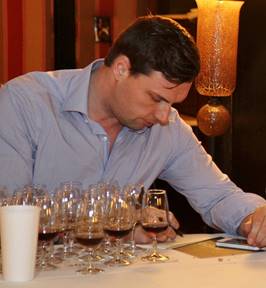 Sean Corrigan |
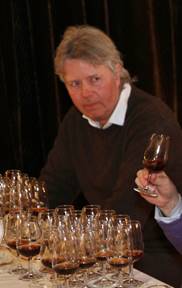 David Boobyer |
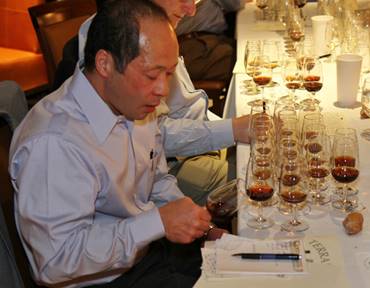 Eric Ifune |
1802 Acciaioly (Reidar Anderson) – Oscar Acciaioly represented the last generation on the island of one of Madeira’s oldest families. Descended from the Dukes of Burgundy, the Acciaiolys arrived in Madeira in the early 1500’s and reputedly brought the Malvasia Babosa grape to the island. When Acciaioly died in 1979, his remaining wines were divided into two parts. One part went to his second wife, who in turn sold them to Mario Barbeito. The second part went to his sons Michael and David, who consigned them, in their original state with original labels, capsules and corks, to Christie’s in London. The sons’ wines were offered at several sales, but principally on July 15, 1989, when more than nine dozen bottles of 1802 Terrantez were sold. The bottle that Reidar Anderson has contributed to today's tasting was purchased by The Rare Wine Co. directly from Vinhos Barbeito in the late 1990s. It was one of the Mario Barbeito bottles that—unlike those sold at Christie’s—were aired for three to four months in 16-liter demijohns, before rebottling with new corks in 1995.
1802 Acciaioly Terrantez Vintage Madeira (Transcendental Terrantez Tasting) – My brother recently reminded me that we had the 1802 Acciaioly Terrantez together years ago at one of Bob Maliner’s Great Wine Seminars in Florida. That was my first time and this is the fourth overall. By far the darkest color of the tasting to this point; dark brown with full opacity and a golden-green edge. Stunning bouquet, “ethereal” doesn’t do it justice and neither will a list of descriptors, but here goes: meaty-beef bouillon like, roasted coffee beans and chestnuts, mahogany, barley sugar, maple and chocolate with hints of lime. Simply profound. The palate is no slouch either. Concentrated and richly textured, seamless and sublime, this Terrantez nectar at 210 years of age has such extraordinary balance due to the intense cut of the acidity which defines precision in wine, is only bested by the depth of the layers of flavor from start to finish. The smoky, off-dry and slightly bittersweet elements that make up the mercurial flavor profile of this singular Terrantez, rivals the best of ANY Madeira, Port, Burgundy, Bordeaux … or wine … for that matter, that I’ve ever put in my mouth. If you are fortunate enough to taste this once in your life, it has been a life worth living. It’s the only Madeira I’ve ever given 100 points to in the past, one of just three wines in nearly 30 years of wine consumption that I’ve perceived to be “perfection”. Thank you for sharing this with us, Reidar! 99 points - 3/10/12
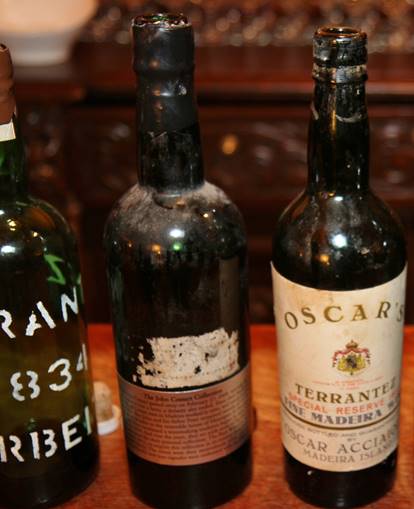
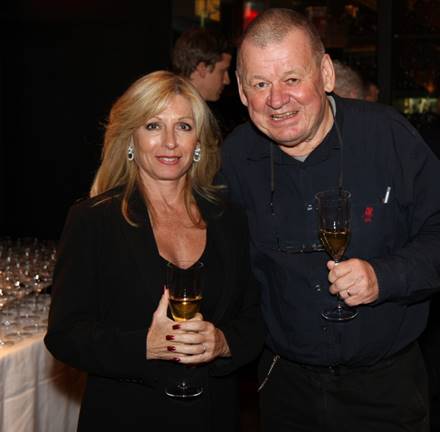
Veronica Maliner & Reidar Andersen
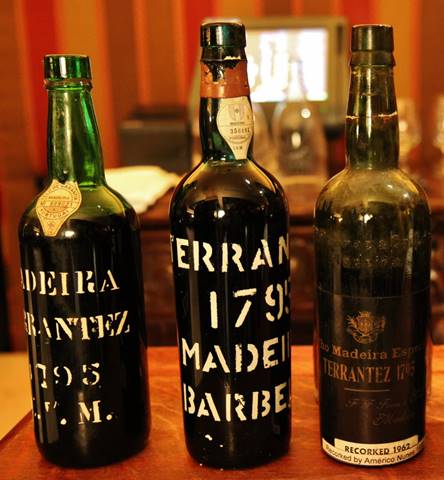
The 1795’s – flight #51795 Companhia Vinicola da Madeira (Alan Gardner) – The Companhia Vinicola da Madeira was founded in 1870 but was absorbed into Justino Henriques decades ago. CVM's cellars were just down Rua dos Ferreiros from Pereira D’Oliveiras; the front of the building is still there. CVM's most famous wine is this 1795, which has appeared a number of times at auction since the 1970s. Forty-four bottles are noted as having been sold since 1971.) The bottle we are tasting was purchased by Alan Gardner at a Christie's auction prior to 1991. It is stenciled with a wax capsule, which distinguishes it from the much larger number of bottles that have paper labels and wicker over the cork. According to Peter Reutter's madeirawineguide.com, "the layout and design of the paper label suggests that the wine has been bottled in the 1960's or 1970's. Most of the producers also stopped using the straw caps on the bottles not later than in the 1970's. The Companhia Vinicola da Madeira by then was an independent company that sold few vintage wines. The remaining stock of vintages of the Companhia was sold by Justino Henriques after Sigfredo da Costa Campos bought Justino in 1981. "According to Patrick Grubb there are variations between the bottlings of the CVM wine, presumably because the bottlings were spaced out over some time and some wine had longer time in wood. There are versions with stencils and versions with labels, Patrick Grubb thinks the former wine superior. "When I wrote to Alex Liddell about the 1795 Terrantez vintages he was very helpful, replying 'that the CVM 1795 Terrantez was at one time (the late 70s or early 80s) sold in England by Corney & Barrow, the reputable city wine merchants in London. I was told (verbally) by a member of the company that it was believed that the wine had been ordered by the Russian imperial family, but remained unshipped before the 1917 Revolution! (I take this conveniently romantic story with a pinch of salt, and know of no independent substantiation of it.) The bottles sold by Corney & Barrow had labels and foil capsules. The labeled bottles with wicker tops appear to be a much earlier bottling. The stenciled bottles were specially bottled by the firm (in the 70s, I think) for a Madeira enthusiast who asked for stencils rather than labels. As far as I know there were only ever 2 dozen of these. I have also encountered slightly differing versions of the label, suggesting bottlings at different times.'" Peter has also researched the possibility that the CVM and Barbeito 1795s came from a common source and ultimately concluded that they didn't.
1795 Companhia Vinicola da Madeira Terrantez Vintage Madeira (Transcendental Terrantez Tasting) – One of just two dozen stenciled CVM bottles ever produced, so this is a real treat. The CVM had the unenviable task of following the 1802 Acciaioly. However, it did so, admirably. Dark shade of molasses with a thin golden-tawny rim. Aromatically, this was one of the great wines on the table, in a lineup filled with natural born talent. A delight to nose this Terrantez packed with scents of iodine, smokiness, ripe nectarine, antique furniture, vanilla extract and a lifted herbal note to round out the chorus line. The freshness of this Madeira at 217 years of age is nothing short of remarkable. The tensity and nerve which is the spine of this wine is brilliantly portrayed by mouth puckering acidity, akin to taking a large bite out of a grapefruit having just woken up. There’s opulence to the CVM’s texture with a seductive sense of silk and richness that meld with delineated fruit flavors of dried dates, figs, tangerine and sweet notes of praline and butterscotch, juxtaposed by a roasted espresso char/bitter edge. The sumptuous never-ending finish left me begging for another sip. The CVM is one of the most beguiling bottles of Terrantez at this event and I hope someday to experience another, if that’s even plausible. 98 points - 3/10/12
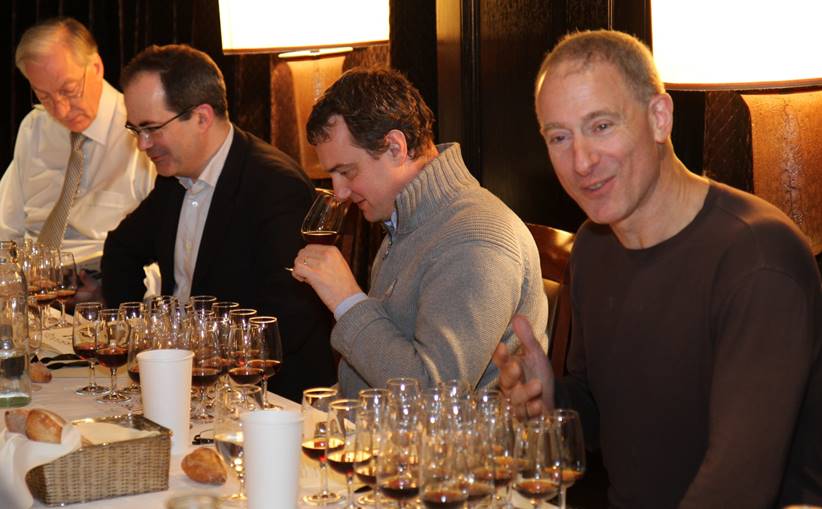
(L-R) Andrew Jones, Paul Day, Neal Martin, Stuart Leaf
1795 Barbeito (Eric Ifune) – According to Peter Reutter, "the 1795 Terrantez by Barbeito is one of the most famous Madeira wines .... As Alex Liddell explains in his book Madeira, this wine originally belonged to the Hinton family. Oscar Acciaioly bought the wine from the Hintons. Later the wine was divided between his descendants. Mario Barbeito bought part of the remaining wine and returned it from demijohns to wood." There were many bottlings of the wine, the last of which was in 2006 and consisted of 23 bottles. That finished Barbeito's stock. Barbeito's daughter Manuela sold many bottles of this wine at auction over the years. We've noted 125 bottles sold between 1971 and 2010. Most came directly from Manuela Barbeito. During the 1990s, she also sold wines described as 1795 Terrantez Garrafeira Particular. Though these bottles contained the same wine, they had stopper corks and typically sold at lower prices. We have noted 45 of these bottles sold at auction.
1795 Barbeito Terrantez Vintage Madeira (Transcendental Terrantez Tasting) – The opportunity to compare and contrast three distinct Terrantezes from 1795 would have been enough to get me to fly 3000 miles from Seattle in order to attend; but with a combined bottle age of over 650 years, it is likely a once-in-a-lifetime proposition, that I don’t take for granted. Only my 5th time trying the Barbeito from this vintage. Medium-dark maple color w/ amber-orange edge. After the CVM, it was apparent this was missing some of the intensity of the previous wine, and in fairness, it was not the best showing of this bottling I’ve experienced. On any other night this would’ve been a terrific show stopper, so it must be kept in context. This 1795 tends more towards the tropical and sweet end of the spectrum; the aromatics were heady and graceful with great purity of vanilla, golden raisins, ripe pineapple, a sweet lavender note, dried leaves and dates, followed by a gentle VA overtone. Densely concentrated and expressive flavors of toffee, dried apricot, mango and mocha/espresso are lovely and accompanied by ample crisp acidity, yet I’d have liked a bit more nerve that would’ve added greater intricacy to the layers, and impact overall. Smooth and viscous right through the enduring elegant finish with a distinctive singed salty/sweet butterscotch tang. 96 points - 3/10/12
1795 F.F. Ferraz (Chris Blandy) - The rarest of the three 1795s being tasted today, only two bottles were spotted at auction between 1971 and 2008. But then 20 bottles were sold in a single day at Christie's Leacock sale, December, 2008. In 1937, the firm of F.F. Ferraz joined other independent merchants in pooling its assets — including its bottled stock of 1795 Terrantez—in the Madeira Wine Association. A significant part of this stock found its way into the personal reserves of the MWA's two managing partners, Edmund Leacock and Graham Blandy. While the history of Edmund's bottles is not known, we can presume that all that remained in 2008 were sold at Christie's. As for Graham Blandy's bottles, in 1938, the year after Ferraz joined, there were 57 bottles in his private reserve at the MWA. By 1954, this number had dwindled to 30. And by 1972, he had only 12 bottles left, enough to give Adam, John and Annabel, his three children, two bottles each. This was as part of a mixed lot of 36 bottles of old Madeira he considered his rarest and best. He wrote his children: "Many of these are of the pre-Phylloxera era (1872) and can be regarded as real museum pieces as they can never be repeated. I hope that when you drink them you will find them still in good condition despite their age and I trust that you will drink with reverence as being of a past age." Thanks to the generosity of Chris and Adam Blandy, we are privileged today to drink one of the prized bottles given by Graham Blandy to his son Adam in 1972.
1795 F.F. Ferraz Terrantez Vintage Madeira (Transcendental Terrantez Tasting) – Admittedly, my expectations of this particular bottle were stratospheric based on discussions with Mannie during the planning of this event and I thought it might rival the 1802 Acciaioly. A slightly cloudy appearance with the color of coca cola and a lime green edge. An undeniable green streak of spearmint and eucalyptus dominated the nose which also offered minerals and exotic scents of VA intertwined with honeysuckle. Although some seemed to love the nose, for me it was too atypical of Terrantez. Very light bodied and alluring across the palate, generously laden with vibrancy and focused acidity throughout, with flavors of esteva, maple, mint, bitter herbs, hazelnut and marmelo, but little in the way of fruit essence. While other guests really liked this Terrantez, a few in the room that were familiar with the Ferraz, felt this bottle was not up to the greatness that it can achieve. 89 points - 3/10/12

18th Century H.M. Borges – final flight, #61790 H.M. Borges (David Boobbyer) – Only fourteen bottles of this rare Terrantez have been noted as selling at auction since 1971. And there have been even fewer appearances outside of auction. This bottle was purchased by Bob Maliner at Sotheby’s on September 25, 1985, as lot 274. Some bottles of 1790 Borges have been described as bottled in Copenhagen by HP Oberbech-Clausens. It's not clear that this is that bottling or an island bottling.
1790 H.M. Borges Terrantez Vintage Madeira (Transcendental Terrantez Tasting) – At a mere 222 years of age, this was the oldest wine/Madeira I’ve ever tasted, until a short while later, when the 1760 passed my lips. Medium-dark maple optic with an amber-greenish tinged rim. My initial whiff was unpleasant with lots of funky fragrances, but over several hours it evolved in the glass and delivered a unique bouquet including vitamin pill, a game meat note, crème brûlée, iodine, pleather, citrus peel, mahogany and a powerful blast of VA. Exhibiting a soft and velvety palate presence in a medium-full frame, along with a concentrated yet simple raft of flavors. As a self-professed “acid freak” the HMB’s level of acidity was so excessive, that it threw off the entire symmetry of this wine. Moderately sweet and with bitter medicinal notes, walnut skin, maple bars, coffee, and lemony citrus; overall I found it angular and the finish was rather short, too bitter and overly acidic. Some others in the room seemed to like this more than me, but nobody seemed wowed by it. When I then compared this to the 1760 that followed, it confirmed my initial impression. Maybe I am a bit too critical of such an ancient Terrantez, after all, some slack should be given due to its age; that being said I did enjoy the overall experience. 87 points - 3/10/12
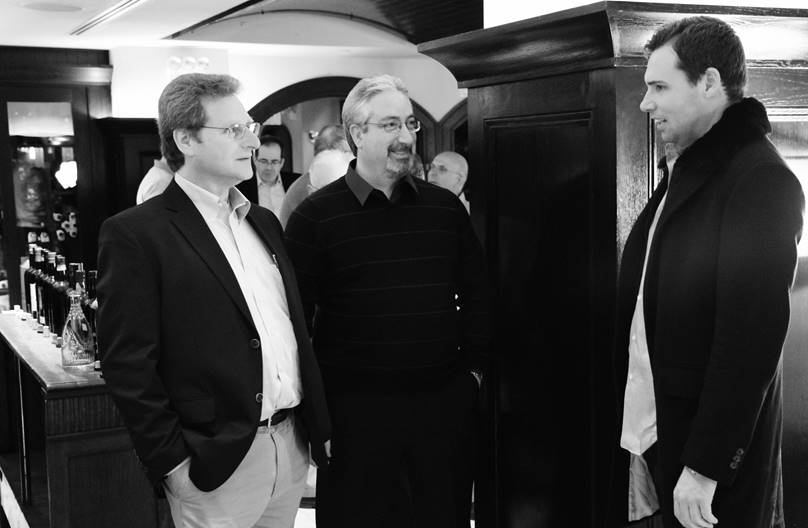
Steve Pollack, Roy Hersh & Sean Corrigan
1760 H.M. Borges (Andrew Jones) – The 1760 H.M. Borges Terrantez was one of several very old Madeiras Henrique Menèzes Borges left to his three children on his death in 1916. According to family legend, H.M. considered these wines to be his best and instructed his children not to sell them. The Madeiras eventually went to one son, João Maria, who on his death in 1989 bequeathed them to his six children. On February 13, 1989, the wines were all bottled from demijohn by H.M. Borges personnel in the presence of the Borges family. The wines were divided equally among the children. Little is known about the origin of these "Borges family wines," including the 1760 Terrantez, except that they are believed to have been acquired by H.M. somewhere around the turn of the 20th century. Though the dates are those given by H.M., they should be considered approximate. Sixteen bottles of the 1760 were bottled from demijohn in 1989, with each child receiving two or three bottles. We know of no bottles having been sold at auction. Andrew Jones purchased this bottle of 1760 Terrantez from one of João Maria's children in 2001.
1760 H.M. Borges Terrantez Vintage Madeira (Transcendental Terrantez Tasting) – Very similar in appearance to the 1790 H.M. Borges that came before it. Likely this will be the oldest bottle of wine that I will drink in my lifetime, so it’s all downhill from here. I’m grateful for this singular experience and honored to taste a Madeira that is older than the country in which I reside. Between sips I remember thinking, ‘it is crazy trying to describe the sensation of a 252 year old wine, and do it justice.’ What I enjoyed most about this ancient HMB is that not only was it still very much alive, but the delicate and dry characteristics of this Terrantez, literally transcend the centuries it has endured. According to some individuals in the room who’ve tasted the 1760 before, it was a “very good showing” and we were all quite fortunate to experience that. The potent profile of this elegant elixir was captured beautifully on the compelling bouquet with an essence of apple cider, pure vanilla, baking spice, roasted chestnut, briny sea air, roasted espresso, waves of wood smoke and a gentle wisp of VA. The mouth presence was unctuous, lithe and captivating while softly caressing the palate in liquid velvet. It took several minutes before I went from deeply inhaling this wine to actually venturing a first sip, as the nose was chameleon-like. There was a bitter-dry aspect to the flavor profile meticulously interspersed with a backdrop of bitter-sweetness which made it all the more beguiling. The first thing I noted was the impeccable integration of the powerful, sharp acidity which precisely melded with warming tastes of marzipan, creamy hazelnut butter, old leather, dried morel mushroom, unsweetened cocoa powder, lemon-lime and nougat. Whereas it started off dry, the end game was filled with salty dark caramel, butterscotch and an indescribable citrus and roasted bitterness which played off the sweet finish and remained on my palate until sampling hors d’oeuvres prior to dinner. An epic, ethereal Terrantez for the ages. 95 points - 3/10/12
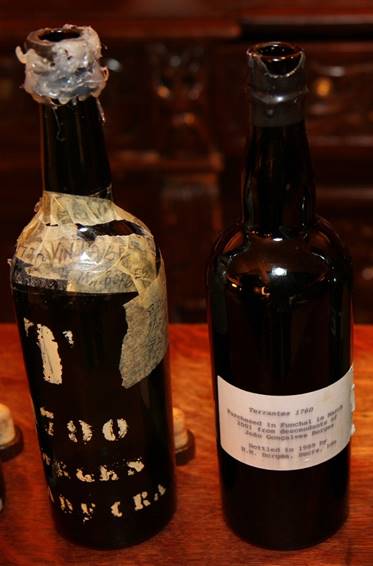
Transcendetal Terrantez Tasting Results
First Flight
1886/1887 Blandy's - 4
1872 Quinta do Serrado - 0
1870 Blandy's - 14Second Flight
1862 Rutherford & Miles - 5
1862 H.M. Borges - 13
Undated H.M. Borges - 0Third Flight
1846 H.M. Borges - 3
1846 Cossart Gordon - 3
1846 Avery's - 6
1846 Leacock - 6Fourth Flight
1834 Barbeito Henriques & Henriques Reserva - 4
1802 Acciaioly - 11Fifth Flight
1795 Companhia Vinicola da Madeira - 11
1795 Barbeito - 5
1795 F.F. Ferraz - 2Sixth Flight
1790 H.M. Borges - 0
1760 H.M. Borges - 18
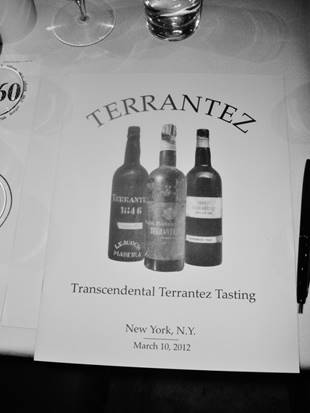
Terrantez Dinner at Del Posto
Saturday, March 10, 2012Charles Heidsieck Champagne Reserve Privee Mise en Cave 1987 en JeroboamFIRST COURSE
- Beef & Truffle Carpaccio, Sunchoke Spuma, Sage Grissini & Sunflower Petals
- 1993 de Venoge Vin des Princes Champagne
- 1988 Henriot Brut Rose of Champagne en Magnum
SECOND COURSE
- Tortello Puzzone with Taleggio Dolce & White Truffle Butter
- 2000 Domaine R & V Dauvissat Chablis La Forest
- 2000 Domaine Leflaive Chevalier Montrachet
- 1990 Jadot Corton Charlemagne
THIRD COURSE
- NY Chicken alla Scarpariello, Porcini Trifolati & Sorana Beans
- 2000 Domaine Arlaud Chambolle Musigny Vieilles Vignes Cuvee Unique
- 1976 Domaine Grivelet Bonnes Mares en Magnum
- 1976 Domaine Grivelet Chambertin en Magnum
FOURTH COURSE
- Wagyu Beef Tenderloin, Black Trumpets, Braised Celery, Toasted Hazelnut, Robiola
- 1989 Marchesi di Barolo Barolo in Magnum
- 1978 Cordero di Montezemolo Barolo Monfalletto
- 1971 Francesco Rinaldi "Barisone" Barolo
- 1964 Oddero Barolo
FIFTH COURSE
- Chef’s Selection of Artisanal Italian Cheeses
- 2001 Gaja Sperss
- 1989 Ch. Ducru Beaucaillou
- 1989 Ch. Lafite Rothschild en Magnum
BISCOTTI ASSORTITI

Reidar Andersen & Peter Reutter
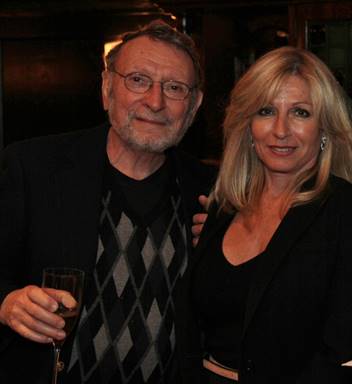
Bob & Veronica Maliner

Bob & Veronica Maliner
Del Posto – New York City – March 10, 2012
Photos by Hans Reutter © March 2012

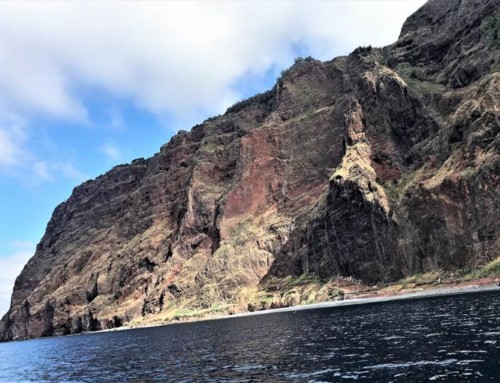
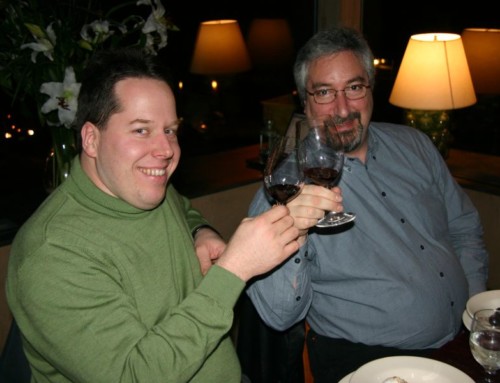
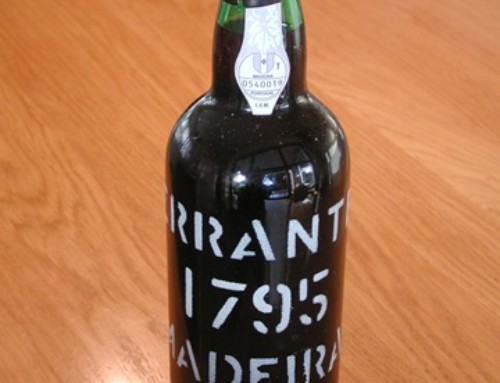
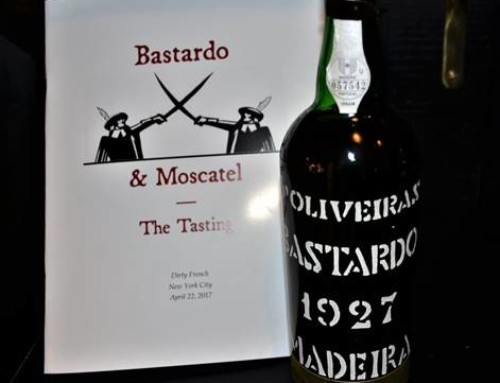
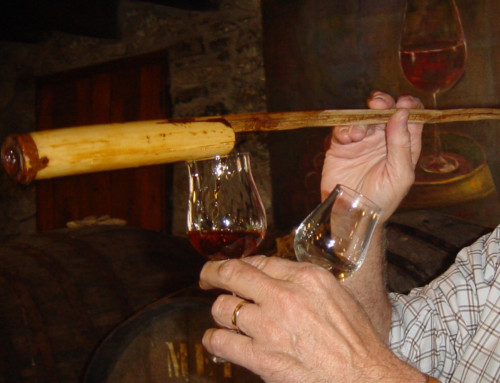
Otherworldly!